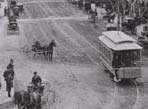
The Automobile Shapes The City
From “Walking Cities” to “Automobile Cities”
A look at the chronology of urban growth in America—with transportation as a key variable—shows how automobiles have transformed cities. Historians have mapped out a three- or four-stage transportation chronology for the American city: walking city (pre-1880), streetcar city (1880-1920), and automobile city (post-1920). One historian has divided the latter period into a “recreational vehicle” period (1920-1945) and a “freeway” period (post-1945).
The first stage—“the walking city”—was marked by highly compact cities and towns; an intermingling of residences and workplaces; a short journey to work for those employed in a variety of tasks; mixed patterns of land use; and the location of elite residences at the city centers. In this era, many cities and towns had large central squares that served as meeting places, open markets for buying and selling goods, and parade grounds for special occasions. For the most part, streets were narrow, meandering, and unpaved. Until the nineteenth century, there were few means other than walking or on horseback to traverse American cities. In 1674 there was only one carriage in New York City, and as late as 1761 only 18 in Philadelphia. In the 1830s, steam locomotives provided opportunity for commuting in major cities, but they were too large, too noisy, and too expensive to incorporate effectively into the urban landscape as a form of inner-city transportation. Late in this period, omnibuses, cablecars, and horsecars (horse-drawn streetcars on fixed track) appeared as the forerunners to the widely adopted electric streetcars that revolutionized mass transit in the United States.
During “the streetcar era,” many cities were feeling the impact of industrialization in terms of factory migration to cities and the influx of thousands of European immigrants and rural American migrants. The industrial cities were focused at the core, especially for various business ventures, commerce and trade, retailing, hotel accommodations, and cultural activities. The separation between work and residence for the middle and upper classes was much more pronounced than in the walking city, as these groups increasingly fled the central cities for the suburbs; the working classes, by contrast, remained near the core and close to industrial workplaces since they had little or no access to public transportation and had to live by the clock or lose their jobs. By the 1880s, low-fare electric streetcars replaced the slower and less reliable horsecars, offering public transportation to a growing ridership. Streetcars, however, still relied on light-rail tracks radiating out from the central business districts into the surrounding areas and newly forming suburbs. Urban development thus congregated close to the streetcar lines.
The intimacy and homogeneity of the walking city declined as the extension of efficient transit allowed the more affluent urbanites to move from the central cities to the more spacious suburbs, escaping inner-city congestion, pollution, and a rising tide of various newcomers. This tendency produced more well-defined residential subdivisions divided primarily along income lines. The smallish walking cities (probably less than a mile in diameter) made way for more expansive urban areas featuring clearer areas of residential segregation and more specialized land uses. Downtowns still had a hold on the big department stores, theaters, and office buildings, but the growing urban periphery saw dynamic population growth and its own demand for public and private services. By the 1920s, the United States could boast of metropolises with suburbs extending more than 20 miles from the core.
The most recent stage—“the automobile (and truck) city”—arose after World War I and began to erode the patterns of the streetcar city through deconcentration of business functions; the weakening of the core as a magnet for social and cultural life; and the dispersal of population into the suburbs. In some respects, the advent of the automobile continued the process of metropolitan growth promoted by the electric streetcars—hastening the decentralization of the population and pushing the suburbs further into the hinterland. Motorized vehicles alone did not produce the new urban patterns. Long distance communications (such as the telegraph and telephone), the extension of city services, and real estate development also contributed mightily to the changes taking place in the late-nineteenth and early-twentieth centuries. Yet the emergence of the automobile gave individuals (and road builders), not fixed tracks, a major role in what became a less clearly defined and less rigidly geometric pattern of urban growth.
Many critics viewed the changes in the automobile era as detrimental to well-planned, rationally organized communities, but others saw motorized vehicles as particularly well-suited to cities. Like the horse and buggy, the car could be privately owned and operated and not restricted to rigid transportation lines. In some places, such as in Los Angeles, Denver, Phoenix, Houston, Jacksonville, and Atlanta, the automobile played a central role in creating low density, expansive, and some would say muddled and fragmented, urban development. In others, modifications in the “urban fabric” occurred at a snail’s pace or not at all.
Adopting the automobile, however, did not guarantee that an appropriate infrastructure would follow. Cars and trucks often had to adjust to urban environments not planned for them. Automobiles in some cities like Paris, for example, often parked on sidewalks along particularly narrow streets. In contrast, in cities that successfully adapted their infrastructure to motorized vehicles, other urban resources were lost and lifestyles were altered. In cities like Los Angeles or Houston, pedestrians have become endangered species.
<<Previous Section - Next Section>>
Introduction
The “Footprint” of the Automobile on the American City
From “Walking Cities” to “Automobile Cities"
Filling Stations and Other Services
Expressways, Freeways, and Superhighways
Complete Text Printable View
Omnibuses, Cablecars and Horsecars
About the Project | Credits | Contact Us | Student & Teacher Resources | Site Map
©2004-2010 Automobile in American Life and Society

